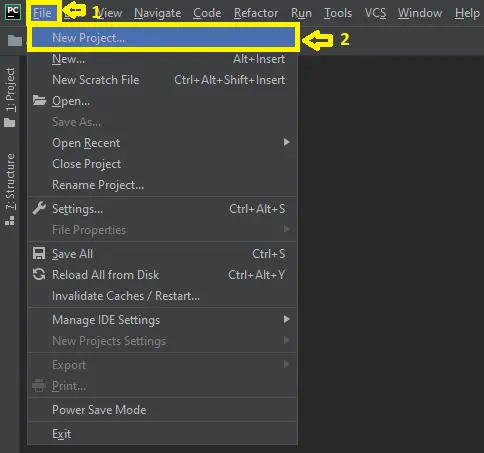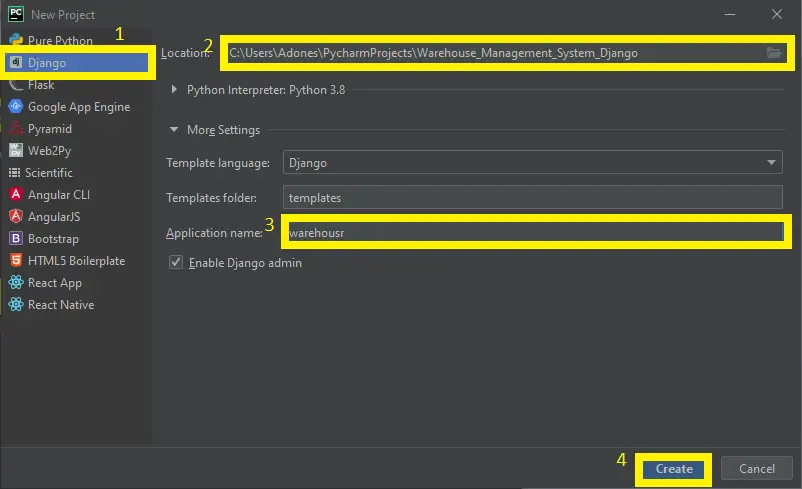This Warehouse Management System in Django created based on python, Django, and SQLITE3 Database.
The Warehouse Management System where admin can update the stock of the particular product, manage farmer, manage user and manage items.
A Warehouse Management System in Django is an easy project for beginners to learn how to build a web-based python Django project.
We will provide you with the complete source code and database for the python project so that you can easily install it on your machine and learn how to program in Python Django.
To start creating a Warehouse Management System Project in Python Django, makes sure that you have PyCharm Professional IDE Installed in your computer.
This Warehouse Management System in Django Framework, Also includes a Download Source Code for free, just find the downloadable source code below and click download now.
Admin Features
- Login Page – The page where the system administrator enters their system credentials in order to gain access to the system’s administrative side.
- Manage farmers – This is the page where an administrator can add, update, view and delete farmers information.
- Manage stocks – This is the page where an administrator can update a stocks.
- Items Management – This is the page where an administrator can add, update, view and delete items information.
- New User Page – The page where a new admin credentials are created by an admin.
- Users list – This is the page that lists and manages the added users.
| About Project | Project Details |
|---|---|
| Project Name | Warehouse Management System Project in Django |
| Python version (Recommended) | 3.8 Version |
| Programming Language Used | Python Django Language |
| Developer Name | itsourcecode.com |
| IDE Tool (Recommended) | Sublime, Visual Studio, PyCharm |
| Project Type | Web Application |
| Database | SQLite |
Warehouse Management System Project in Django Steps on How to Create a Project
Time needed: 5 minutes
Here are the steps on how to create a Django Warehouse Management System with Source Code.
- Step 1: Open file.
First , open “pycharm professional” after that click “file” and click “new project”.

- Step 2: Choose Django.
Next, after click “new project“, choose “Django” and click.

- Step 3: Select file location.
Then, select a file location wherever you want.

- Step 4: Create application name.
After that, name your application.

- Step 5: Click create.
Lastly, finish creating project by clicking “create” button.

- Step 6: Start Coding.
Finally, we will now start adding functionality to our Django Framework by adding some functional codes.
Functionality and Codes of the Warehouse Management System Project in Django with Source Code
- Create template for the store form in Warehouse Management System Project in Django.
In this section, we will learn on how create a templates for the store form. To start with, add the following code in your store.html under the folder of store/templates/store.
{% extends 'basic/base.html' %}
{% block content %}
<div class="container" style="margin-top: 2%">
<div class="row">
<div class="col-lg-6" style="background-color: #324491; height: 200px; border-radius: 10px; float: left">
<div style="display: flex; justify-content: center;">
<h1 style="color: #8099dc;">
<u>
Profile
</u>
</h1>
</div>
<div>
{% for farmer in Farmer%}
<h2 style="color: white">
<b style="color: #202020">Name:-</b> {{farmer.user.username}}
</h2>
<h2 style="color: white">
<b style="color: #202020">Phone No.:-</b> {{farmer.phone_number}}
</h2>
<h2 style="color: white">
<b style="color: #202020">Address:-</b> {{farmer.address}}
</h2>
{% endfor %}
</div>
</div>
<div class="col-lg-6" style="float:right; color: black">
<h1 style="color: #26346d; float: right">
<u><b>Total Inventory</b></u>
</h1>
<h4 style="float: right">
{% for item, qnt in dict.items %}
<p> {{item}} is available {{qnt}} units.</p>
{% endfor %}
</h4>
<br><br><br>
<h1 style="color: #26346d; float: right">
<u><b>Your storages</b></u>
</h1>
<h4 style="float: right">
{% for stock in dict2 %}
<p> {{stock.item.name}} - {{stock.quantity}} stored on {{stock.stored_date}} </p>
{% endfor %}
</h4>
</div>
</div>
</div>
{% endblock %}
- Create template for the homepage in Warehouse Management System Project in Django.
In this section, we will learn on how create a templates for the homepage. To start with, add the following code in your base.html under the folder of basic/templates/basic.
{% load staticfiles %}
<html lang="en">
<head>
<title>Warehouse</title>
<!-- Required meta tags -->
<meta charset="utf-8">
<meta name="viewport" content="width=device-width, initial-scale=1, shrink-to-fit=no">
<link rel="shortcut icon" type="image/png" href="{% static 'icons/icon.png' %}"/>
<!-- Bootstrap CSS -->
<link rel="stylesheet" href="https://maxcdn.bootstrapcdn.com/bootstrap/4.0.0-beta.2/css/bootstrap.min.css" integrity="sha384-PsH8R72JQ3SOdhVi3uxftmaW6Vc51MKb0q5P2rRUpPvrszuE4W1povHYgTpBfshb" crossorigin="anonymous">
<link rel="stylesheet" href="{% static 'css/basic/basic.css' %}">
<script src="https://use.fontawesome.com/f2c1d88751.js"></script>
<style>
body {
background-color: skyblue;
-webkit-background-size: cover;
-moz-background-size: cover;
-o-background-size: cover;
background-size: cover;
}
@font-face {
font-family: Liber;
src: url('{% static 'fonts/Liber.ttf' %}') format("truetype");
src: local('{% static 'fonts/Liber.ttf' %}') format("truetype");
}
.myfont{
font-family: 'Liber', sans-serif;
}
</style>
</head>
<body>
<nav class="navbar navbar-expand-lg navbar-light" style="background-color: black;">
<a class="navbar-brand" href="{% url 'home_page'%}" style="color: #a2ffba; font-size:x-large ; font-family: Liber "Roboto", "Helvetica Neue", Helvetica, Arial, sans-serif">Myrel Food Warehouse</a>
<button class="navbar-toggler" type="button" data-toggle="collapse" data-target="#navbarSupportedContent" aria-controls="navbarSupportedContent" aria-expanded="false" aria-label="Toggle navigation">
<span class="navbar-toggler-icon"></span>
</button>
<div class="collapse navbar-collapse" id="navbarSupportedContent">
<ul class="navbar-nav mr-auto">
<li class="nav-item">
<a class="nav-link" style="color: white" href="{% url 'home_page' %}">
<i class="fa fa-home " aria-hidden="true"></i>
Home
</a>
</li>
<li class="nav-item">
<a class="nav-link" style="color: white" href="{% url 'store' %}">
<i class="fa fa-archive" aria-hidden="true"></i>
Store
</a>
</li>
<li class="nav-item">
<a class="nav-link" style="color: white" href="{% url 'sell' %}">
<i class="fa fa-money" aria-hidden="true"></i>
Sell
</a>
</li>
<li class="nav-item">
<a class="nav-link" style="color: white" href="{% url 'buy' %}">
<i class="fa fa-shopping-cart" aria-hidden="true"></i>
Buy
</a>
</li>
<li class="nav-item">
<a class="nav-link" style="color: white" href="{% url 'more' %}">
<i class="fa fa-info-circle" aria-hidden="true"></i>
More
</a>
</li>
<li class="nav-item">
<a class="nav-link" style="color: white" href="{% url 'about_us' %}">
<i class="fa fa-address-card" aria-hidden="true"></i>
About Us
</a>
</li>
</ul>
<ul class="navbar-nav ml-auto">
{% if user.is_authenticated %}
<li class="nav-item">
<a class="nav-link" style="color: red" href="{% url 'store' %}">
<i class="fa fa-user" aria-hidden="true"></i>
Hi, {{user.username}}
</a>
</li>
{% else %}
<li class="nav-item">
<a class="nav-link" style="color: white" href="{% url 'login' %}">
<i class="fa fa-sign-in" aria-hidden="true"></i>
Login
</a>
</li>
<li class="nav-item">
<a class="nav-link" style="color: white" href="{% url 'signup' %}">
<i class="fa fa-user-plus" aria-hidden="true"></i>
SignUp
</a>
</li>
{% endif %}
{% if user.is_authenticated %}
<li class="nav-item">
<a class="nav-link" style="color: white" href="{% url 'logout' %}">
Logout
<i class="fa fa-power-off fa-lg" aria-hidden="true"></i>
</a>
</li>
{% endif %}
</ul>
</div>
</nav>
{% block content %}
{% endblock %}
<!-- Optional JavaScript -->
<!-- jQuery first, then Popper.js, then Bootstrap JS -->
<script src="https://code.jquery.com/jquery-3.2.1.slim.min.js" integrity="sha384-KJ3o2DKtIkvYIK3UENzmM7KCkRr/rE9/Qpg6aAZGJwFDMVNA/GpGFF93hXpG5KkN" crossorigin="anonymous"></script>
<script src="https://cdnjs.cloudflare.com/ajax/libs/popper.js/1.12.3/umd/popper.min.js" integrity="sha384-vFJXuSJphROIrBnz7yo7oB41mKfc8JzQZiCq4NCceLEaO4IHwicKwpJf9c9IpFgh" crossorigin="anonymous"></script>
<script src="https://maxcdn.bootstrapcdn.com/bootstrap/4.0.0-beta.2/js/bootstrap.min.js" integrity="sha384-alpBpkh1PFOepccYVYDB4do5UnbKysX5WZXm3XxPqe5iKTfUKjNkCk9SaVuEZflJ" crossorigin="anonymous"></script>
</body>
</html>
- Create template for the about us page in Warehouse Management System Project in Django.
In this section, we will learn on how create a templates for the about us page. To start with, add the following code in your about_us.html under the folder of aboutus/templates/aboutus.
{% extends 'base.html' %}
{% block content %}
<div class="dashboard-wrapper">
<div class="container-fluid dashboard-content">
<div class="col-xl-12 col-lg-10 col-md-11 col-sm-12 col-xl-7 mx-auto">
{% if messages %}
{% for message in messages %}
<div class="col-lg-12 mr-auto ml-auto alert bg-warning alert-dismissable pb-0 pt-0" role="alert">
<button type="button" class="close" data-dismiss="alert" aria-label="Close">
<span aria-hidden="true" class="text-danger"><b>×</b></span>
</button>
<div class="row">
<div class="mr-auto ml-auto">
<p class="h5 mr-auto ml-auto p-2 text-light">
<b>
{% if message.tags == "alert-danger" %}
<i class="fa fa-exclamation-triangle mr-3 text-danger"></i> {{ message }}
{% else %}
<i class="fa fa-check"></i> {{ message }}
{% endif %}
</b>
</p>
</div>
</div>
</div>
{% endfor %}
{% endif %}
<div class="card">
<h5 class="card-header h5">Add A New Shepherd </h5>
<div class="card-body">
<form action="{% url 'create_shepherd' %}" method="post" class="mb-5">
{% csrf_token %}
<div class="form-group mb-5">
<label for="{{ form.name.id_for_label }}">Shepherd Name</label>
<input type="text" class="form-control" id="{{ form.name.id_for_label }}" name="{{ form.name.name }}" autofocus required>
</div>
<div class="form-group">
<label for="{{ form.age.id_for_label }}">Shepherd Age</label>
<input type="text" name="{{ form.age.name }}" id="{{ form.age.id_for_label }}" class="form-control">
</div>
<button class="btn btn-success mt-5 text-light shadow btn-sm">Add Shepherd</button>
</form>
</div>
</div>
</div>
</div>
</div>
{% endblock content %}Downloadable Source Code Below.
Anyway, if you want to level up your programming knowledge, especially python, try this new article I’ve made for you Best Python Projects with source code for Beginners.
But If you’re going to focus on web development using Django, you can download here from our list of Best Django Projects with source code based on real-world projects.
How To Run The Warehouse Management System Project in Django?
- Step 1: Extract/unzip the file
- Step 2: Go inside the project folder, open cmd and type the following commands to install Django Framework and run the webserver:
- python manage.py migrate
- python manage.py runserver
- Step 3: Finally, open the browser and go to http://127.0.0.1:8000/
Summary
In summary, this Warehouse Management System Project in Django with Source Code can be useful to students or professional who wants to learn python programming language.
This project can also be modified to fit your personal requirements. Hope this project will help you to improve your skills. Happy Coding!
Related Articles
- Laravel Warehouse Management System with Source Code
- Inventory Management System in Laravel With Source Code
- DFD for Inventory Management System
- Inventory Management System Project In Python Source Code
- Inventory Management System Project in ASP.net with Source Code
- Inventory Management System in Android Studio with Source Code
- Component Diagram for Inventory Management System | UML
Inquiries
If you have any questions or suggestions about Warehouse Management System Project in Django with Source Code, please feel free to leave a comment below.





